Marc Leepson's Blog, page 4
May 5, 2023
May 2023
Volume XX, Number 5 May 2023
“The study of the past is a constantly evolving,never-ending journey of discovery.” – Eric Foner

ANEXCELLENT MAN: As I found out while doing theresearch for Saving Monticello,Jefferson M. Levy, like his uncle Uriah P. Levy, was a New York City residentwho did not live full time at Monticello during the years (1879-1923) that heowned it. But Jefferson Levy did spend considerable amounts of time, including manysummer weekends, at Thomas Jefferson’s Charlottesville, Virginia, “Essay inArchitecture” during the 44 years when he was its proud owner.
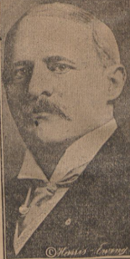 I recently found more evidence to buttress thefact that Jefferson Levy frequented Monticello regularly, especially in theearly twentieth century, in a recently digitized newspaper clipping. It’scontained in one of the massive scrapbooks of clippings of newspaper articles*in which Jefferson Levy (in a 1914newspaper photograph, right) is mentioned in the archives of the Centerfor Jewish History. You can browse through them online at https://bit.ly/JMLCollectionCJH
I recently found more evidence to buttress thefact that Jefferson Levy frequented Monticello regularly, especially in theearly twentieth century, in a recently digitized newspaper clipping. It’scontained in one of the massive scrapbooks of clippings of newspaper articles*in which Jefferson Levy (in a 1914newspaper photograph, right) is mentioned in the archives of the Centerfor Jewish History. You can browse through them online at https://bit.ly/JMLCollectionCJH
Said evidence: a brief, kind-of gossipy articlein the May 22, 1911, New York Herald,on the occasion of JML’s “return to the halls of Congress.” Levy, an extremelysuccessful lawyer and real estate and stock speculator, had been re-elected to theHouse of Representatives in the fall of 1910 and took his seat in March 1911. Adecade earlier he had served in the House for one term, from 1899-1901, representingNew York's 13th Congressional District in Manhattan.
Levy, a conservative Democrat, would be “anexcellent man for his district,” the article predicted, pointing to the factthat he’d had experience on Capitol Hill with his earlier term in the House,and that he therefore knew “the ropes and wires better than a new man.”
The article went on to say that as proud ashe was to be a member of Congress, Jefferson Levy was “prouder yet,” of owningMonticello, which in 1911 he had owned for more than three decades. Keeping up the“reputation for hospitality” that Monticello “enjoyed in Jefferson’s time,” thearticle noted, Levy “takes down a gay party of his cronies nearly everyweek-end.”
I couldn’t help pondering the ironic fact that at the time thearticle was published and Jefferson Levy was hosting regular jolly parties atMonticello, the ardent Thomas Jefferson devotee Maud Littleton was launchingher national campaign to take Monticello from him and turn it into a government-runhouse museum—a campaign, as I show inSaving Monticello, tainted by the stench of anti-Semitism.
After resolving that the property shouldnot belong to Jefferson Levy, Maud Littleton spent the first half of 1911furthering her knowledge of the history of Monticello. That resulted in herwriting and publishing “One Wish,” a sixteen-page tract mailed out toinfluential friends around the country that summer. That emotional plea for anend to the Levy family’s ownership of Monticello was the start of a bitter,contentious, three-year battle between Mrs. Littleton and her allies andJefferson Monroe Levy and his supporters over who would own Monticello.
The bitterness ended in the fall of 1914when Jefferson Levy—who once said that he would sell Monticello only when theWhite House was for sale—agreed to let the government have the house and its600-plus acres, plus all its furniture and furnishings, for $500,000. Thatmollified Maud Littleton, but the sale never happened as Congress couldn’t cometo grips with the asking price.
All interest in Monticello on Capitol Hill endedwhen the U.S. entered World War I in 1917. Five years after the war JeffersonLevy sold Monticello to the newly formed Thomas Jefferson Foundation for his$500,000 asking price.
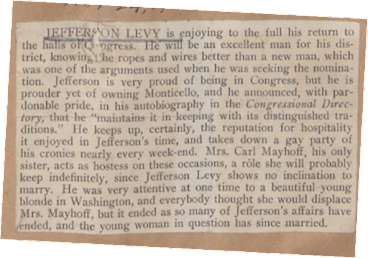
*Those big scrapbooks, which I went through page-by-page at theCenter for Jewish History archives back in pre-digital days (1999), are made upprimarily of newspaper articles in which Jefferson Levy is mentioned. Heemployed a clipping service, a long-gone, pre-Internet business that searchedfor and then physically cut out newspaper articles and sent them to clients.
When I started my journalism career in 1974 at CongressionalQuarterly we had two full-time people serving as our in-house clipping service.Every day they’d go through scores of daily newspapers with a red pencil searchingfor topics that the magazine’s and other CQ news services’ reporters wereworking on and then “clip” them out with a metal ruler and deliver them to us. Thatlow-tech “search engine” had nothing on Google, but it worked very well back inthe 1900s.
MEA CULPA: URIAHLEVY’S WORTH: In the April issue I mentioned that, as I wrote in Saving Monticello, Uriah Levy was listed as one of thewealthiest men in Manhattan in the 1855 edition of Moses Beach’s The Wealth and Biography of the WealthyCitizens of the City of New York. And that Beach estimated Levy to be worth$500,000.
I had an email from an attentive newsletter subscriber, Harry Zimmerman, whosaid that while doing research for a play he is writing about Uriah Levy, hecame across the Beach book and saw that the figure was not $500,000, but $250,000.
I checked my files and he is correct, as you cansee from the image of the entry below—although the comma looks like a periodand the last zero somehow was dropped. How I managed to double that figure whenI wrote the book more than twentyyears ago escapes me. But it happened. And if the book ever goes into a secondedition, I will correct that error.
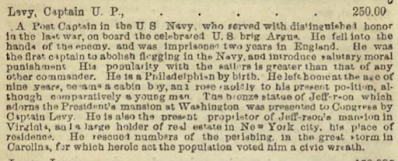
Thatmisstep got me thinking about how much $250,000 in 1855 would be worth today. SoI went online and found several inflation calculator websites. I also found outthat the sites use educated guesses forpre-1913 inflation figures because the U.S. Bureau of Labor Statistics only began tabulating inflation data in 1913.
I went to three inflationcalculator sites, plugged in $250,000 and 1855, and they all came up with approximatelythe same figure: that Uriah P, Levy that year was worth the equivalent of morethan $8.5 million in 2023.
THE DOC: Steven Pressman’s great documentary, “The Levys ofMonticello,” which was inspired by SavingMonticello, is making its last round of film festivals this spring. Next upis a screening in Brookline, Mass., on May 8 during the National Center forJewish Film’s annual Film Festival. For info, go to https://bit.ly/ScreeningBoston
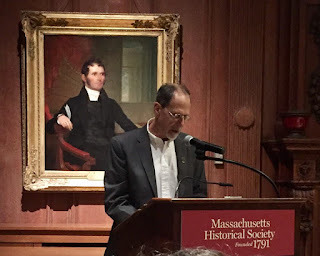
EVENTS: Here are details about my May author events:
On Tuesday,May 9, I’ll be doing a talk and book signing on the life of Francis ScottKey, based on my book, What So Proudly WeHailed: Francis Scott Key, A Life, at the McLean (Virginia) HistoricalSociety.
On Tuesday,May 23, the topic will be Saving Monticellofor my talk and book signing for the Resident Forum speaker series at the HeritageHunt Retirement Community in Gainesville, Virginia.
Fordetails on other upcoming events, check the Events page on my website: https://bit.ly/NewAppearances
GIFT IDEAS: For a personally autographed, brand-new paperback copy of Saving Monticello, please e-mail marcleepson@gmail.com I also have a few as-new, unopened hardcovercopies, along with a good selection of new copies of my other books: Flag: An American Biography; DesperateEngagement; What So Proudly We Hailed; Flag:An American Biography; and Ballad ofthe Green Beret: The Life and Wars of Staff Sgt. Barry Sadler.
Volume XX, Number 5 May...
Volume XX, Number 5 May 2023
“The study of the past is a constantly evolving,never-ending journey of discovery.” – Eric Foner

ANEXCELLENT MAN: As I found out while doing theresearch for Saving Monticello,Jefferson M. Levy, like his uncle Uriah P. Levy, was a New York City residentwho did not live full time at Monticello during the years (1879-1923) that heowned it. But Jefferson Levy did spend considerable amounts of time, including manysummer weekends, at Thomas Jefferson’s Charlottesville, Virginia, “Essay inArchitecture” during the 44 years when he was its proud owner.
 I recently found more evidence to buttress thefact that Jefferson Levy frequented Monticello regularly, especially in theearly twentieth century, in a recently digitized newspaper clipping. It’scontained in one of the massive scrapbooks of clippings of newspaper articles*in which Jefferson Levy (in a 1914newspaper photograph, right) is mentioned in the archives of the Centerfor Jewish History. You can browse through them online at https://bit.ly/JMLCollectionCJH
I recently found more evidence to buttress thefact that Jefferson Levy frequented Monticello regularly, especially in theearly twentieth century, in a recently digitized newspaper clipping. It’scontained in one of the massive scrapbooks of clippings of newspaper articles*in which Jefferson Levy (in a 1914newspaper photograph, right) is mentioned in the archives of the Centerfor Jewish History. You can browse through them online at https://bit.ly/JMLCollectionCJH
Said evidence: a brief, kind-of gossipy articlein the May 22, 1911, New York Herald,on the occasion of JML’s “return to the halls of Congress.” Levy, an extremelysuccessful lawyer and real estate and stock speculator, had been re-elected to theHouse of Representatives in the fall of 1910 and took his seat in March 1911. Adecade earlier he had served in the House for one term, from 1899-1901, representingNew York's 13th Congressional District in Manhattan.
Levy, a conservative Democrat, would be “anexcellent man for his district,” the article predicted, pointing to the factthat he’d had experience on Capitol Hill with his earlier term in the House,and that he therefore knew “the ropes and wires better than a new man.”
The article went on to say that as proud ashe was to be a member of Congress, Jefferson Levy was “prouder yet,” of owningMonticello, which in 1911 he had owned for more than three decades. Keeping up the“reputation for hospitality” that Monticello “enjoyed in Jefferson’s time,” thearticle noted, Levy “takes down a gay party of his cronies nearly everyweek-end.”
I couldn’t help pondering the ironic fact that at the time thearticle was published and Jefferson Levy was hosting regular jolly parties atMonticello, the ardent Thomas Jefferson devotee Maud Littleton was launchingher national campaign to take Monticello from him and turn it into a government-runhouse museum—a campaign, as I show inSaving Monticello, tainted by the stench of anti-Semitism.
After resolving that the property shouldnot belong to Jefferson Levy, Maud Littleton spent the first half of 1911furthering her knowledge of the history of Monticello. That resulted in herwriting and publishing “One Wish,” a sixteen-page tract mailed out toinfluential friends around the country that summer. That emotional plea for anend to the Levy family’s ownership of Monticello was the start of a bitter,contentious, three-year battle between Mrs. Littleton and her allies andJefferson Monroe Levy and his supporters over who would own Monticello.
The bitterness ended in the fall of 1914when Jefferson Levy—who once said that he would sell Monticello only when theWhite House was for sale—agreed to let the government have the house and its600-plus acres, plus all its furniture and furnishings, for $500,000. Thatmollified Maud Littleton, but the sale never happened as Congress couldn’t cometo grips with the asking price.
All interest in Monticello on Capitol Hill endedwhen the U.S. entered World War I in 1917. Five years after the war JeffersonLevy sold Monticello to the newly formed Thomas Jefferson Foundation for his$500,000 asking price.

*Those big scrapbooks, which I went through page-by-page at theCenter for Jewish History archives back in pre-digital days (1999), are made upprimarily of newspaper articles in which Jefferson Levy is mentioned. Heemployed a clipping service, a long-gone, pre-Internet business that searchedfor and then physically cut out newspaper articles and sent them to clients.
When I started my journalism career in 1974 at CongressionalQuarterly we had two full-time people serving as our in-house clipping service.Every day they’d go through scores of daily newspapers with a red pencil searchingfor topics that the magazine’s and other CQ news services’ reporters wereworking on and then “clip” them out with a metal ruler and deliver them to us. Thatlow-tech “search engine” had nothing on Google, but it worked very well back inthe 1900s.
MEA CULPA: URIAHLEVY’S WORTH: In the April issue I mentioned that, as I wrote in Saving Monticello, Uriah Levy was listed as one of thewealthiest men in Manhattan in the 1855 edition of Moses Beach’s The Wealth and Biography of the WealthyCitizens of the City of New York. And that Beach estimated Levy to be worth$500,000.
I had an email from an attentive newsletter subscriber, Harry Zimmerman, whosaid that while doing research for a play he is writing about Uriah Levy, hecame across the Beach book and saw that the figure was not $500,000, but $250,000.
I checked my files and he is correct, as you cansee from the image of the entry below—although the comma looks like a periodand the last zero somehow was dropped. How I managed to double that figure whenI wrote the book more than twentyyears ago escapes me. But it happened. And if the book ever goes into a secondedition, I will correct that error.

Thatmisstep got me thinking about how much $250,000 in 1855 would be worth today. SoI went online and found several inflation calculator websites. I also found outthat the sites use educated guesses forpre-1913 inflation figures because the U.S. Bureau of Labor Statistics only began tabulating inflation data in 1913.
I went to three inflationcalculator sites, plugged in $250,000 and 1855, and they all came up with approximatelythe same figure: that Uriah P, Levy that year was worth the equivalent of morethan $8.5 million in 2023.
THE DOC: Steven Pressman’s great documentary, “The Levys ofMonticello,” which was inspired by SavingMonticello, is making its last round of film festivals this spring. Next upis a screening in Brookline, Mass., on May 8 during the National Center forJewish Film’s annual Film Festival. For info, go to https://bit.ly/ScreeningBoston

EVENTS: Here are details about my May author events:
On Tuesday,May 9, I’ll be doing a talk and book signing on the life of Francis ScottKey, based on my book, What So Proudly WeHailed: Francis Scott Key, A Life, at the McLean (Virginia) HistoricalSociety.
On Tuesday,May 23, the topic will be Saving Monticellofor my talk and book signing for the Resident Forum speaker series at the HeritageHunt Retirement Community in Gainesville, Virginia.
Fordetails on other upcoming events, check the Events page on my website: https://bit.ly/NewAppearances
GIFT IDEAS: For a personally autographed, brand-new paperback copy of Saving Monticello, please e-mail marcleepson@gmail.com I also have a few as-new, unopened hardcovercopies, along with a good selection of new copies of my other books: Flag: An American Biography; DesperateEngagement; What So Proudly We Hailed; Flag:An American Biography; and Ballad ofthe Green Beret: The Life and Wars of Staff Sgt. Barry Sadler.
April 8, 2023
April 2023
Saving Monticello: The Newsletter
The latest about the book, author events, and more
Newsletter Editor - Marc Leepson
Volume XX, Number 4 April 2023
“The study of the past is a constantly evolving,never-ending journey of discovery.” – Eric Foner

URIAH LEVY’S BUSINESSDEALINGS: Peopleoften ask me how Uriah Levy, a U.S. Navy lieutenant, had the means to buyThomas Jefferson’s Monticello in 1834, and then oversee repairing and restoringit, and then run the house and plantation until his death in 1862. The shortanswer is that Levy, who was born in 1892 and started his Navy career in 1812,made a small fortune mainly through savvy real estate dealings in New York.
As I wrote in Saving Monticello, whenthe 35-year-old Navy lieutenant (inuniform, in the painting below, circa 1815) moved to New York City inJanuary 1828, he began investing in real estate. That year he bought threerooming houses in Greenwich Village, two on Duane Street and one on GreenwichStreet. Levy subsequently purchased seven additional rooming houses in theVillage and elsewhere in lower Manhattan. It was a propitious time to do so.
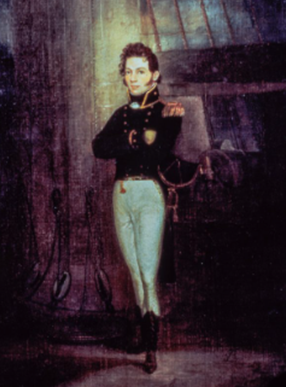
GreenwichVillage experienced a growth spurt in the 1820s. As the old farming village’s streetswere paved and sidewalks flagged, the area’s population increased, property values rose and hundreds of new businesses opened. Itbecame home to carpenters, masons, painters, stonecutters, and otherblue-collar workers, soon followed by middle-class merchants and tradesmen.
Levyamassed a not inconsiderable fortune through his New York City real estateholdings. In 1855, he was listed as one of the wealthiest men in Manhattan in MosesY. Beach’s The Wealth and Biography ofthe Wealthy Citizens of the City of New York. Beach estimated Levy to beworth $500,000. He and August Belmont (1816-90), the German-born banker anddiplomat, were the only Jewish people on Beach’s list.
That was the extent of my knowledge about Uriah Levy’s business dealings—untila few weeks ago. That’s when I received an email from Lori Kimball, a historianand archivist who specializes in the history of Loudoun County, Virginia—wherewe both live.
Loritold me that in her work in the Historic Records Room at the Loudoun CountyCourthouse in Leesburg she and her colleague Eric Larson had come across twodocuments that showed that Uriah P. Levy had other business dealings aside fromthose in New York City.
Onewas a May 17, 1834, Deed of Trust, in which Uriah Levy “in the Navy of theUnited States,” his cousin Mordechai Noah, and a man named James Monroe (notthe President, who lived in Loudoun, but had died in 1831), “both of the cityof New York,” loaned $6,000 to a prominent Loudoun County citizen, George Rust,and his wife Maria Clagett Rust.
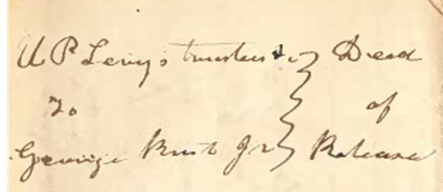
TheRusts put up three piece of property as collateral for the loan: Rockland, his 503-acrecountry home outside Leesburg, a parcel of land in the town of Leesburg, and a44-acre tract on the Potomac River. They made the semi-annual 7 percentinterest payments on the loan for nearly six years. Then, as a February 3,1840, Deed of Release (in the above image)showed, George Rust paid back the principal four years later, and Levy andcompany released the properties.
Thisfairly high-level business deal led me to two questions. Was U Uriah Levy inthe habit of lending money? And did he venture to Loudoun County in May1834—about a month after he purchased Monticello? Going through my researchmaterials accumulated over the last 25 years, I was unable to find the answerto either question.
Mysupposition is that it’s unlikely this was the only such loan Uriah Levy madeand that he could have been in Loudoun at this time as we know that he was inAlbemarle County about a hundred miles south of Leesburg in the spring of 1834.
Butthat’s conjecture, and I will continue to look for evidence of Levy’s otherbusiness dealings and his travels to the northwestern part of Virginia. Staytuned.
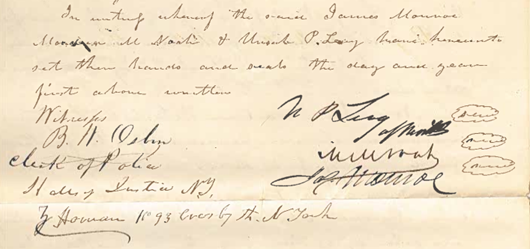
Postscript: On the signature page ofthe Deed of Trust, as you can see in the image above, Uriah Levy (barelylegibly) signed his name, “U.P. Levy of Monticello.”
THERIMONIM, PART II: Last month Ireported on the two ornate eighteenth century silver Torah finials called Rimonimthat had been at the center of a dispute between Congregation Shearith Israel inNew York and Touro Synagogue in Newport, Rhode Island. I mentioned that theyhad been on loan to the Boston Museum of Fine Arts, and illustrated the postingwith a generic image of Rimonim. Then I learned, through emails from attentivenewsletter subscribers, that the finials are still on display at FMA, and thatthe Museum’s website includes a photo (below)of them, along with excellent interpretation, which provides more details aboutthe unique—and valuable—objects.
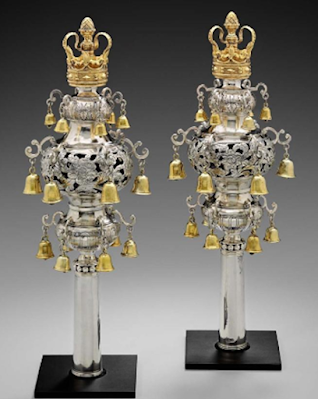
The Rimonims’finial bells make “festive sounds when they are carried around the synagogue,”the museum notes. “Their Hebrew name ‘Rimonim’ means pomegranates, because ofthe round shape recalling the biblical symbolic fruit.
“This splendid pair, on loan from Congregation Shearith Israel in New York(est. 1654), is an exceptionally rare example of colonial American Judaica.They were made by Myer Myers, a Jewish silversmith who led the market in18th-century New York.” Myers “produced luxury silverware for both domestic andreligious use for [his] Jewish and non-Jewish clients.
“These finials hold a very special place in Jewish American history…. They were… probably in the Newport synagogue during GeorgeWashington’s famous visit on August 18th, 1790. Today the New York congregationuses the beautiful Rimonim during the High Holidays.”
The U.S.S. LEVY: As I reported in Saving Monticello, the first time theUnited States Navy honored Uriah Levy’s exceptional 50-year naval careercame during World War II when a destroyer escort was christened the USS Levy.
That ship, one of the first of its kind in the Navy, servedin the southern and central Pacific from August 1943 through the end of the wartwo years later, seeing action in many engagements, including the two-monthBattle of the Philippine Sea in the summer of 1944.
In August and September 1945 the ship’s officers took partin surrender ceremonies of the Japanese Navy in the southeastern MarshallIslands. They negotiated and accepted the surrender of Mille (sometimes spelledMili) Atoll on August 21 and witnessed the surrender of Jaluit Atoll later thatmonth. On September 4, the Japanese officially surrendered Wake Island toMarine Corps Brig. Gen. Lawson. H. M. Sanderson aboard the Levy.
Not long after Saving Monticello came out inNovember 2001, my friend Julie Coles told me that her late father, Daniel F.Evans, had served as a 22-year-old gunnery officer on the ship during the war.And that he took part in the surrender ceremonies. Then, just last week, shesent me the image at left that her father kept in his scrapbook.
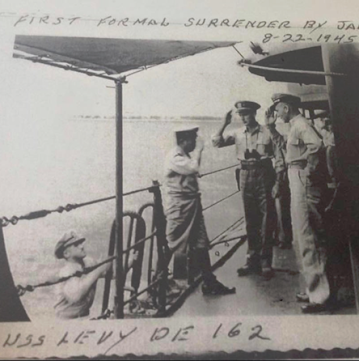
That’s Daniel Evans with the binoculars around his neck,saluting one of the three Japanese officers who came on board on August 21,most likely Navy Capt. Masanori Shigaone
Julie told me that her fathersaid that he and Lt. Cmdr. William Clarenback (to Evans’ left) were chosen to greet the Japanese officers because theywere tall men and their commanding officer Capt. Harold B. Grow wanted themthere to tower over and humiliate the Japanese.
She also said her father toldher that after the picture was taken the officer committed ritual suicide.
You can find more info on theU.S.S. Levy during World War II ontwo excellent, well-illustrated web sites: https://bit.ly/USSLevyand https://bit.ly/4USSLevyPhotos
THE DOC:Steven Pressman’s great documentary, “The Levysof Monticello,” which was inspired by SavingMonticello, continues to appear at film festivals across the country.
On Wednesday, April 19, there’ll be an in-personscreening at the Center for Jewish History at the American Jewish HistoricalSociety in New York City. For details, go to: https://bit.ly/AJHSLevys
Wehad a screening on March 14 at TheHill School in Middleburg, Virginia, where I live, sponsored by our town’slibrary friends group, the Middleburg Library Advisory Board. It was a greatevent, after which I took questions from the audience and then signed copies ofthe book at the best book-signing table I’ve ever had, which was set up by alocal shop, Crème de la Crème. Yes, that’s a lamp, a potted plant, and twotable cloths adorning the table.
EVENTS: Here are details about my four events in April:
· Sunday, April 2, talk on SavingMonticello, and book signing at Congregation Beth Am Israel in Penn’sLanding, Pennsylvania.
· Tuesday, April 11, talk for the Sons of Confederate Veterans Camp, in Winchester,Virginia, on my only Civil War book, Desperate Engagement
· Saturday, April 15, talk at historic City Tavern in Washington,D.C. on the life of Francis Scott Key, sponsored by the City Tavern Preservation Foundation. This is a free event and is open to thepublic, with registration required through Eventbrite at https://www.eventbrite.com/e/551699807977
· Sunday,April 16, talk on Desperate Engagement for the Washington, D.C., chapter ofthe Daughters of theUnion Veterans of the Civil War
If you’dlike to arrange an event for SavingMonticello or for any of my other books, email me at marcleepson@gmail.comFor details on other upcoming events, check the Events page on my website: https://bit.ly/NewAppearances
GIFT IDEAS: For a personally autographed, brand-new paperback copy of Saving Monticello, please e-mail marcleepson@gmail.com I also have a few as-new, unopened hardcovercopies, along with a good selection of new copies of my other books: Flag: An American Biography; DesperateEngagement; What So Proudly We Hailed; Flag:An American Biography; and Ballad ofthe Green Beret: The Life and Wars of Staff Sgt. Barry Sadler.
March 9, 2023
March 2023
Saving Monticello: The Newsletter
The latest about the book, author events, and more
Newsletter Editor - Marc Leepson
Volume XX, Number 3 March 2023
“The study of the past is a constantly evolving, never-ending journey of discovery.” – Eric Foner

SHEARITH ISRAEL V. TUORO:
Here’s a quick, two-part Jewish-American History quiz that has connections to the Levy and Nunez families: Name the oldest Jewish Congregation in the United States and the oldest synagogue in the country. Hint: They are two different entities.
If you said Shearith Israel in New York City and Touro Synagogue in Newport, Rhode Island, you are correct. Congregation Shearith Israel has the distinction of being the first Jewish Congregation in the nation, having been founded in 1654 by Sephardic Jews who had immigrated to Nieuw Amsterdam, as the city was then known, from Brazil.
Touro Synagogue, formally known as Jeshuat Israel, is the second oldest congregation, having been founded a few years later, also by Sephardic Jews. But it holds the honor of being the oldest American synagogue, as its current building was erected 1763.
Shearith Israel’s massive Beaux Arts building on Central Park West (the Congregation’s fourth, in photo below) is a relative newcomer, having been completed in 1897.
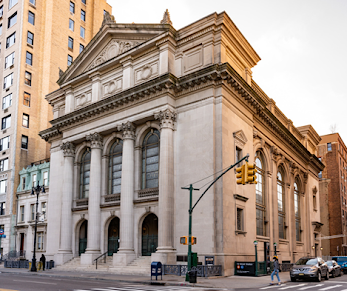
Members of the Nunez and Levy families have been associated with Shearith Israel since around 1735 when Uriah Levy’s great grandmother Maria Caetana Nunez (known as Zipporah), and her husband, David Mendes Machado, moved to New York from Savannah, Georgia, when he was appointed hazzan at Shearith Israel.
Fast forwarding to the late 19th century, Louis Napoleon Levy—Jefferson Levy’s brother, fellow attorney, and real estate business partner—served as the president of Shearith Israel for many years beginning in 1895.*
Which brings us to something I just learned: the longtime and not always harmonious relationship between Shearith Israel and Tuoro, and L. Napoleon Levy’s role in the late 1890s and early 1900s dispute between the two congregations that had its roots in the mid-18th century—and ramifications that continued until 2019.
It’s a very long and complicated story, spelled out in legal documents that run to hundreds of pages. What follows is a short summary of the dispute, which centered on which party owned the physical Tuoro building and religious ornaments housed there.
The ownership question hinged on the fact that in the mid-1700s religious institutions in Rhode Island could not incorporate or own land. So when a group of Jews in Newport raised the funds to buy land for its synagogue—including money donated by Shearith Israel—three community leaders were chosen to serve as trustees for the building and land: Jacob Rodrigues Rivera, Moses Levy, and Isaac Hart.
Soon after that, around the time the Touro Synagogue was consecrated in 1763, a noted silversmith named Myer Myers made an elaborate pair of silver Remonim (finials for the synagogue’s Torah) for the congregation. In 1793, after most of Newport’s Jews departed the city during the Revolutionary War, regular services ended; by 1822, there were no Jewish people in the city.
Some of the departed Newport Jews joined Shearith Israel. They brought with them the Rimonim and other religious articles, which were kept at Shearith Israel for safekeeping, with the understanding that they would be returned to Tuoro once worship services started again. The word “Newport” was engraved on their bases so as not to confuse them with a similar pair owned by Shearith Israel.
During the time that Touro (below) was inoperative Shearith Israel helped take care of the synagogue, including holding the building’s keys and making it available for occasional funerals, high holiday services, and special occasions. During that time period, too, Shearith Israel became the official trustee for Touro—although as with the case of the original and subsequent trustees, Shearith Israel never owned the building or the Rimonim.
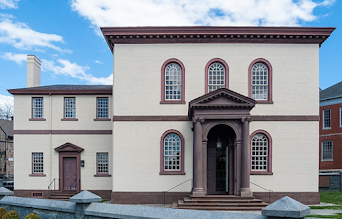
In the 1870s Jews began returning to Newport and religious services began again at Touro. The new rabbi, Abraham Pereira Medes of London, was chosen by Shearith Israel, in its role as Touro’s trustee. In 1894, the Rhode Island Legislature granted articles of incorporation to the newly named Jeshuat Israel congregation which to this day worships at Touro Synagogue.
Shearith Israel returned the Rimonim to Jeshuat Israel in the late 1800s or early 1900s. During that time, though, a series of legal battles took place between Shearith Israel and Touro over the former’s concern that Newport synagogue was moving away from Sephardic forms of worship. To make matters more complicated, in March 1899 Touro’s congregants split into two groups, both claiming control of the synagogue. Following several lawsuits, the synagogue temporarily closed.
One group, calling itself “Touro Congregation,” tried to hold services in the building, but was forcibly removed. There was a brief reconciliation, but on January 1, 1901, Shearith Israel and like-minded Touro congregants closed the synagogue. A year later, a group made up primarily of members of the self-described Touro Congregation broke into the building to pray and then staged a sit-in. It lasted for a year during which regular religious services were held.
Meanwhile the Newport and New York congregations faced off in the courts. A federal judge ruled in January 1903 for Shearith Israel in a case that was argued by L. Napoleon Levy, the congregation’s president. In David v. Levy Jeshuat Israel, agreed “to admit and recognize without qualification the title and ownership of L. Napoleon Levy and acting trustees [of Shearith Israel] to the synagogue building, premises and fixtures…”
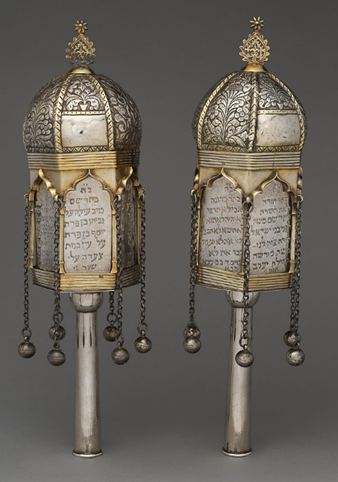 The court ruling also ordered L. Napoleon Levy and the acting trustees to “make a lease thereof to the Congregation Jeshuat Israel for five years from February 1, 1903, at the nominal rent of one dollar year.” Not long after that ruling Jeshuat Israel chose its first Ashkenazic rabbi, Jacob M. Seidel, while agreeing to conduct services using Sephardic rituals.
The court ruling also ordered L. Napoleon Levy and the acting trustees to “make a lease thereof to the Congregation Jeshuat Israel for five years from February 1, 1903, at the nominal rent of one dollar year.” Not long after that ruling Jeshuat Israel chose its first Ashkenazic rabbi, Jacob M. Seidel, while agreeing to conduct services using Sephardic rituals.
That situation remained in effect—with Jeshuat Israel running Touro Synagogue, Shearith Israel acting as trustee for the building—for more than a century. Then, in 2012, the two congregations once again faced off after the Touro moved to sell some items to raise funds for restoring its building. That included, according to court documents, a $7.4 million offer from the Boston Museum of Fine Arts for the Rimonim.
On June 29, 2012, Shearith Israel issued a letter demanding that Jeshuat Israel cease and desist from selling the Rimonim, based on the fact that it remained the trustee of the building and its contents. When mediation attempts failed, both sides were to trial in 2015. The case is officially called Congregation Jeshuat Israel v. Congregation Shearith Israel.
A year after a U.S. District Court Judge ruled in 2016 against Shearith Israel the congregation appealed that order to the U.S. Court of Appeals in Boston, which overturned the decision. Touro appealed that decision to the U.S. Supreme Court, which declined to take up the case on March 18, 2019. And today the Rimonim remain in Tuoro—and Shearith Israel remains the trustee of Touro Synagogue.
At least that’s how I read it. You can read the detailed history of the entire matter—up to the 2016 ruling—on line at https://bit.ly/TourovShearith
************************
*As for L. Napoleon Levy’s presidency of the Shearith Israel Congregation, I mentioned in the January newsletter that he held that office from 1895-1896. That was not correct. In fact, L. N. Levy was president of Shearith Israel for much longer. How much longer I am still trying to find out, but I have found primary source materials showing that he was president in the following years: 1897, 1908, 1910, 1919, 1920, and 1921 and very likely in the years in between. L.N. Levy died at age 66 on April 9, 1921.
THE DOC: Steven Pressman’s great documentary, “The Levys of Monticello,” continues to appear at film festivals across the country. Here are details on three upcoming screenings:
On Sunday, March 13, it will be shown at the St. Louis Jewish Community Center as part of the 28th annual St. Louis Jewish Film Festival. Details: https://bit.ly/StLouisJFF
On Wednesday, March 22, it will be part of the New Hampshire Jewish Film festival with a in-theater screen. Steve Pressman will take part in a Q&A following the screening. Details: https://tinyurl.com/47sydvf3
On Wednesday, April 19, There’ll be an in person screening at the Center for Jewish History at the American Jewish Historical Society in New York City. Details: https://bit.ly/AJHSLevys
EVENTS: The highlight of my March is a Q&A I will be doing on Tuesday, March 14, at the Hill School auditorium in Middleburg, Virginia, following a screening of “The Levys of Monticello.” The event, sponsored by the Middleburg Library Advisory Board (the Library's Friends group) begins at 6:00 p.m. Details: https://bit.ly/ScreeningMB
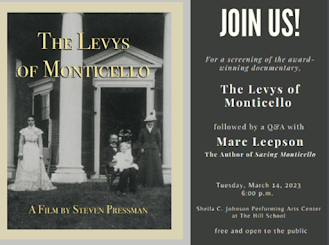
If you’d like to arrange an event for Saving Monticello or for any of my other books, email me at marcleepson@gmail.comFor details on other upcoming events, check the Events page on my website: https://bit.ly/NewAppearances
GIFT IDEAS: For a personally autographed, brand-new paperback copy of Saving Monticello, please e-mail marcleepson@gmail.com I also have a few as-new, unopened hardcover copies, along with a good selection of new copies of my other books: Flag: An American Biography; Desperate Engagement; What So Proudly We Hailed; Flag: An American Biography; and Ballad of the Green Beret: The Life and Wars of Staff Sgt. Barry Sadler.
February 5, 2023
February 2023
Saving Monticello: The Newsletter
The latest about the book, author events, and more
Newsletter Editor - Marc Leepson
Volume XX, Number 2 February 2023
“The study of the past is a constantly evolving, never-ending journey of discovery.” – Eric Foner

ANATOMY OF A PHOTOGRAPH: In early 1917, the bitterly contentious effort to take Monticello from Jefferson Levy and turn it into a government-run presidential house museum was entering its fifth year. The first congressional hearings on the idea had taken place in the summer of 1912, a fiery spectacle as Maud Littleton, a Long Island, New York, socialite, and her allies battled it out with Jefferson Monroe Levy over his ownership of Thomas Jefferson’s Essay in Architecture.
For more than two years, Jefferson Levy had vowed he would not let Monticello go. Why should he? It had been in his family since his uncle Uriah Phillips Levy purchased it in 1834; he and his uncle saved it from ruin twice; and he had not the slightest inclination to sell.
“When the White House is for sale, then I will consider an offer for the sale of Monticello, and not before,” he said soon after Mrs. Littleton (as she was known in the press) began her single-minded campaign to wrest Monticello from “outsiders,” as her literature put it.
Then, in the fall of 1914, Jefferson Levy, a well-heeled real estate and stock speculator, made a shocking announcement: After a plea from President Woodrow Wilson, Levy said he would sell Monticello—for $500,000. That number, he said, was about a third of what he had spent in the previous 35 years repairing, restoring, running, and persevering the house and grounds—as well as adding significant acreage to the property and lavishly furnishing every room in the mansion.
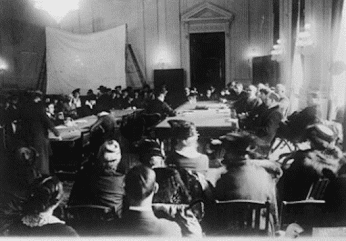
As I wrote in Saving Monticello, on January 9, 1917—while Europe was stalemated in the third bloody year of what would become known as World War I—yet another congressional hearing convened to debate Monticello’s fate. This time the Senate Committee on Public Buildings and Grounds met to discuss a resolution that called for the government to purchase Monticello for Levy’s asking price and use it as a Virginia getaway for U.S. presidents, what Camp David in Maryland is today.
In the weeks following that hearing there still seemed to be fairly widespread sentiment in Congress for the government purchase of Monticello. In an effort to keep the momentum for a sale alive, Daisy Allen Story the Present General of the Daughters of the American Revolution—which had volunteered to run the house museum—arranged for a large group of congressmen to make a personal inspection of Monticello.
On Sunday morning, January 28, 1917, a party of 40 men and 27 women—including many members of the House Committee on Public Buildings and Grounds and their wives—boarded two chartered Southern Railway cars for the trip to Charlottesville. The train arrived shortly after noon.
The party—which also included Daisy Story (in photo, below) and members of the DAR’s national Board of Directors—was met at the train station by a delegation from the local Chamber of Commerce and whisked up to snow-covered Monticello in two dozen automobiles. The lead vehicle was decorated with two huge American flags donated by the DAR.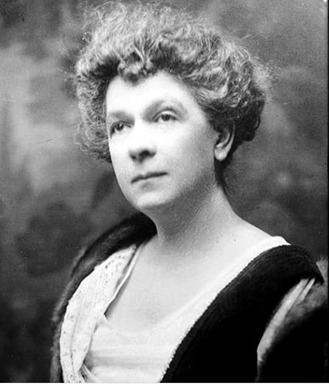
The group gathered on Monticello’s East Lawn to take in the mountain views and then proceeded to the East Front steps where Jefferson M. Levy greeted them. The guests took a guided tour of all of Monticello’s rooms before sitting down to a lavish lunch in the dining room. Levy brought in a phalanx of Black waiters and maids for the occasion.
“The spread set out by the genial host of today was in keeping with the traditional hospitality of the famous mansion,” the Charlottesville Daily Progress reported. “An elegant menu was served the many guests, whose appetites had been whetted by the three-mile drive in the bracing mountain air, and they did full justice to the elegant and toothsome viands which had been provided.” Several newspaper and newsreel photographers were on hand, although the images they took have not survived.
Until now, that is. Bill Bergen, a former long-time Monticello guide and one of the most knowledgeable Monticello historians I know, has unearthed a striking photo that almost certainly portrays the group posing on the East Front steps. Bill filled me in on the detective work he performed to identify the photo.
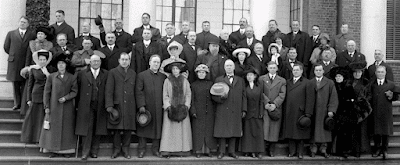
More than a few years ago, Bill said, he had scanned the image, which he found in the Thomas Jefferson Foundation photo files in the Jefferson Library.” The image was simply labeled “unidentified group.”
Then, a couple of weeks ago, Bill immediately thought of that undated and unidentified group photo after reading a Facebook post by the Richmond (Va.) journalist Coy Barefoot. In it, he posted several articles from the January 29, 1959, Charlottesville Daily Progress, one of which looked back on that date in local history an item for the newspaper’s January 29, 1917 edition.
To wit: “A delegation of about 70 from the Committee on Public Buildings and Grounds of the House of Representatives inspected Monticello yesterday in connection with the proposed purchase of Jefferson's home by the national government.”
“I had forgotten about the visit,” Bill told me, “and it occurred to me the mystery photograph might depict that occasion.” His first step was to go to Saving Monticello where he found the passage that I paraphrased above with the details of the January 29, 1917, congressional visit. Next, Bill unearthed a list of the committee’s 1917 members, as well as images of nearly all 21 of them. “By comparing those online images with the men in the attached picture,” he said, “I identified 12 people whose visages seem to match.”
More evidence pointing to this being the 1917 images, Bill said, was the fact that everyone in it is wearing winter clothing, as well as “the presence of women [presumably spouses and DAR members], two individuals in uniform (the U.S. had not yet declared war, but National Guard units were expanding at that time), and the general fashions depicted, which suggest a date somewhere close to the U.S. entry into World War I.”
What’s more, he said, other images of the Entrance Hall taken early in early 1917 show the windows adorned with curtains, as the photograph in question does. And photographs depicting the same Entrance Hall in the early 1920s after the Thomas Jefferson Foundation purchased Monticello from Jefferson Levy “show the same windows without curtains,” which “supports the idea that the congressional delegation photo was not taken during the Foundation’s ownership.”
As for the nine men aside from the committee members in the images, they most likely were “hangers-on, aides, or, quite likely, other politicians, including members of the Virginia congressional delegation. Fewer than the 70 or so people mentioned [in the newspaper article] are in the photograph, so not everyone who made the trip posed for the photographer.”
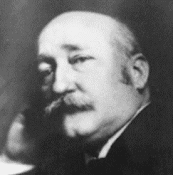
After a closer look, Bill and I believe we recognized one of the non-committee members in the photo. The bald-headed man with the bushy white moustache wear the fur-collared jacket in the third row from the bottom just to the right of the man with the full beard very likely is Judge R.T.W. “Tom” Duke Jr., Jefferson Levy’s Charlottesville lawyer (in right photo). Alas, Jefferson Levy—not exactly a camera-shy man—does not appear in the photo.
I am thankful to my friend Bill Bergen for some great historical sleuthing and for sharing it with me. When he suggested that I might want to report on it in the newsletter, I replied, “Let me think about it for a minute—Yes!”
***********************
By the way, that congressional visit was not exactly a success. The problem—of all things—was Jefferson Levy’s refusal to serve wine with lunch. When the thirsty congressmen and company asked Levy to show them Jefferson’s wine cellar, he responded, according to a Roanoke Timesarticle I dug up, that “he had left the keys in New York.”
“‘Well, that’s all right,’ said some of the leading committee members. ‘We’ll just break in the door and make a hole in the floor.’
“But Levy said, ‘No’ and would not budge from the decision.”
That brought about “much grumbling” from the distinguished guests, the newspaper said, “and it was freely rumored that Mr. Levy would have to materially reduce his offer [to sell Monticello to the government] below $500,000 if he expected Congress to buy the old Jefferson home.”
Whether or not that last line was sarcastic, and whether the lack of wine accompanying that meal had any impact on the congressmen, the fact remains that the 64thCongress adjourned on March 3, 1917, without taking any action on any of the Monticello resolutions.
And when the U.S entered the Great War the next month the matter was dropped.
THE DAVID STATUE: As we noted in the October and November 2021 issues of the newsletter, the New York City Council decided two years ago that it no longer wanted the larger-than-life statue of Thomas Jefferson that had been in its chambers since it was donated to the city by Uriah Levy in 1834. The statue—to be more precise, the plaster model of said statue commissioned by Levy from the great French sculptor David d’Angers, the original of which is in the U.S. Capitol Rotunda—was then moved to the lobby of the New-York Historical Society building on Central Park West at 77th Street.
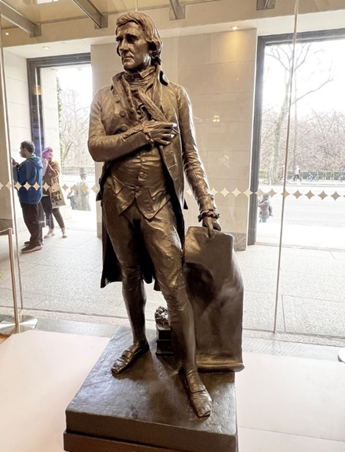
My friend and colleague Steve Pressman, the writer and director of “The Levys of Monticello,” paid a visit to the museum last month, and kindly sent me the photo (right) and the following on-the-spot report:
I was in New York City to see some art exhibitions and dropped by the New-York Historical Society to take in a fun exhibit about Jewish delis—alas, a vanishing breed both in NYC and the rest of the country.
Before entering the world of pastrami-on-rye and bagel schmears, I was delighted to come across an instantly recognizable figure right inside the main entrance to the building—a seven-foot statue of Thomas Jefferson, quill pen in hand, gazing earnestly at the passersby.
On the day of my visit to the Historical Society, most of the other visitors brushed right by the Jefferson statue, apparently far more eager to pay their respects to the memories of the Carnegie and Stage Delis, both of which, sadly, are no longer with us.
But I chose instead to linger, at least for a few moments, out of respect for both Thomas Jefferson and Uriah Phillips Levy. Both men, to be sure, owned enslaved people—and I’m mindful of their moral contradictions that we continue to grapple with centuries later. Still, I was happy to see the d’Angers statue at its new home in New York City—with or without half-sour pickles.
THE DOC: Steve’s great documentary, “The Levys of Monticello,” continues to appear at film festivals across the country. On Wednesday, February 8, at 7:00 p.m. it will be screened at the Charlotte (North Carolina) Jewish Film festival at that city’s Temple Israel. For more info, go to https://bit.ly/CharlotteLevys
On Wednesday, February 15, the film will be shown as part of the 33rd Annual Orange County International Jewish Film Festival in Southern California. Info at: https://bit.ly/OrangeCoFestival
And on Sunday, February 26, I’ll be taking part in a post-screening Q&A at the Samuel C. Johnson Theater at Norfolk Academy in Norfolk, Virginia, as part of the Virginia Festival of Jewish Film. The event begins at 2:30 p.m. More info: https://bit.ly/NorfolkFestival
FEBRUARY EVENTS: In addition to the event in Norfolk, I’ll be doing a talk on the life of Francis Scott Key, based on my biography What So Proudly We Hailed, on Monday, February 5, via Zoom for the Peter Minuet DAR chapter of New York City.
On Monday, February 20, at 2:00 p.m. I’ll be talking about Saving Monticello via Zoom for the Bender JCC of Greater Washington (D.C.). Steve Pressman will be joining me as we also discuss the making of “The Levys of Monticello.”
If you’d like to arrange an event for Saving Monticello or for any of my other books, email me at marcleepson@gmail.com For details on other upcoming events, check the Events page on my website: https://bit.ly/NewAppearances

GIFT IDEAS: For a personally autographed, brand-new paperback copy of Saving Monticello, please e-mail marcleepson@gmail.com I also have a few as-new, unopened hardcover copies, along with a good selection of new copies of my other books: Flag: An American Biography; Desperate Engagement; What So Proudly We Hailed; Flag: An American Biography; and Ballad of the Green Beret: The Life and Wars of Staff Sgt. Barry Sadler.
The SM Newsletter on Line: You can read back issues of this newsletter at http://bit.ly/SMOnline
January 9, 2023
January 2023
Saving Monticello: The Newsletter
The latest about the book, author events, and more
Newsletter Editor - Marc Leepson
Volume XX, Number 1 January 2023
“The study of the past is a constantly evolving, never-ending journey of discovery.” – Eric Foner
THE LEVYS OF NEW YORK: Saving Monticello, the story of Uriah Levy and Jefferson Monroe Levy’s 89-year stewardship of Thomas Jefferson’s Essay in Architecture in Virginia’s Blue Ridge Mountains, naturally focuses on Monticello and Charlottesville. But the story of the Levys also threads through New York City, where both men lived for most of their lives.
So here’s a brief tour of the Big Apple through the lives of Uriah and Jefferson Levy and their forebears and close relations who lived and worked there, primarily in Lower Manhattan, Greenwich Village, Murray Hill, and Central Park West.
We begin with Uriah Levy’s great grandparents, Maria Caetana Nunez and David Mendes Machado, who helped settle Savannah, Georgia, in July 1733 with 38 other Sephardic Jews who had escaped the Portuguese Inquisition, sailed to London, and then to the New World.
Not long after arriving in Savannah with her family, 19-year-old Maria Nunez (known as Zipporah) married David Machado. Soon thereafter, the young couple relocated to NYC, where Machado, a Jewish theologian and scholar, became hazzan at Congregation Shearith Israel, the first Jewish congregation established in North America.
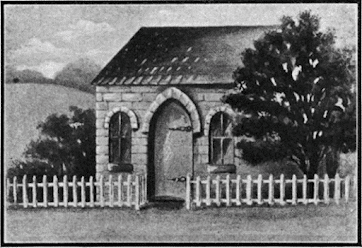
That Sephardic congregation was founded in 1654 by the first Jews who had come to Niuw Amsterdam from Brazil. Until 1825, it was the only Jewish congregation in the city. When the Machados arrived in Manhattan, the congregation was meeting in a small house on Mill Street (in drawing, above)—the first building designed to be used as a synagogue in North America. Mill Street, now known as South William Street, is in Lower Manhattan near Wall Street.
Zipporha and David’s oldest daughter, Rebecca Machado, was born in New York in 1746. She married Jonas Phillips—a merchant who had immigrated to the colonies from Germany—in 1762 in Philadelphia. They lived in Manhattan for a while, where Jonas Phillips owned and operated a retail store. The couple moved to Philadelphia in the early 1770s. Their grandson, Uriah Phillips Levy, was born there in 1792, the son of their daughter Rachel Phillips and Michael Levy, who had come to the U.S. from Germany.
Uriah Levy grew up in Philadelphia and joined the U.S. Navy in 1812 to fight in the war against England. That brought him to New York for the first time, when on October 21, 1812, the 20-year-old received his official U.S. Navy appointment as a Sailing Master from President James Madison and briefly served on the U.S.S. Alert in New York Harbor.
After the war, in January of 1828, Uriah returned to New York City, and never left—except for his Navy postings and his visits to Monticello, which he purchased in 1834. Soon after arriving in New York, Uriah began investing in real estate, specializing in rooming houses in Greenwich Village and elsewhere in Lower Manhattan. He quickly amassed a not inconsiderable fortune through his New York City real estate holdings.
Sometime in the winter of 1836-37, Uriah bought and moved into a four-story brick house on East 9th Street in what is now known as the East Village. That structure, between 3rd and 4thAvenues, is long gone.
UPL lived there with his widowed mother, Rachel Phillips Levy, and his unmarried sister Amelia. His mother died at Monticello in 1839 while Uriah was at sea and is buried there. In the early 1850s Uriah moved to another large East Village house at 107 St. Mark’s Place between First Ave and Avenue A. That building was demolished and today is the site of a six-story brick apartment building.
Jonas Phillips Levy, Uriah youngest brother, who was born in Philadelphia in 1807, lived in New York City periodically throughout his life, and settled there for good in 1866 after the Civil War. He had married Frances Mitchell (known as Fanny) in 1848.
Their four children, including Jefferson Monroe Levy, were born and raised in Manhattan. When Jefferson Levy was born in 1852 his parents were living on Bank Street in the West Village. Earlier, they had lived at 498 West Houstan (Houston) Street on a block near the Hudson River that no longer exists. At his death in 1883, Jonas Levy was living with his wife Fanny at 108 E. 40th St., between Lexington and Park Avenues in Murray Hill.
Jefferson Levy, a lawyer by trade, became an extremely successful real estate and stock speculator. Over the years, he rented office space in several buildings in Lower Manhattan, including at 38 Park Row, 30 Pine Street, and 100 Broadway, one block from Wall Street. Today, the latter is the site of the Neo-Renaissance, 26-story American Surety building, one of New York’s earliest skyscrapers, which was completed in 1896. (See recent photo of the entrance below.)
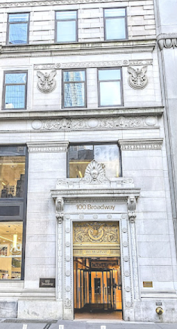
Jefferson Levy’s younger brother and business and law partner, Louis Napoleon Levy, lived with his wife Lillian Hendricks Wolff and their four daughter at 18 West 72nd Street, a stone’s throw from Central Park on the Upper West Side not far from Shearith Israel, where he served as president of the congregation from 1895-96. The family later moved a few blocks south to 26 West 69thStreet.
Jefferson Levy’s sister, Amelia Levy Mayhoff, who was born in 1858, married Carl Mayhoff, a New York City cotton broker, in 1890. They lived most of the year on East 34thStreet, on the same block where Jefferson Levy lived between Lexington and Park Avenue, a few blocks from the Empire State Building.
Jefferson Levy later moved three blocks north to 17 East 37th Street, between Madison and Fifth, close to famed financier John Pierpont Morgan’s library, now known as the Morgan Library & Museum. That’s where Jefferson Levy died on March 6, 1924, of heart disease, five weeks short of his 72nd birthday.
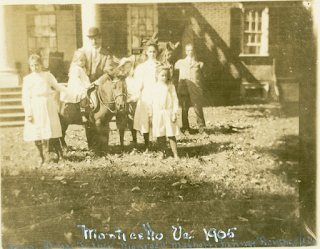 THE DOC: Steven Pressman’s great documentary, “The Levys of Monticello,” continues to appear at film festivals. And get great reviews: Here’s the latest from the St. Louis Jewish Light: https://tinyurl.com/mw6t7t88 And here are this month’s screenings, both live and virtual:
THE DOC: Steven Pressman’s great documentary, “The Levys of Monticello,” continues to appear at film festivals. And get great reviews: Here’s the latest from the St. Louis Jewish Light: https://tinyurl.com/mw6t7t88 And here are this month’s screenings, both live and virtual: · January 12, 7:00 p.m. in person screening at the New Orleans JCC. Info: https://tinyurl.com/2p82dhpm
· January 13-25, Miami Jewish Film Festival, streaming. Info at https://tinyurl.com/mws7687x
· January 22at 2:00 p.m, at the Virginia Museum of History & Culture in Richmond, Va., as part of the 14th annual Israeli and Jewish Film Festival. Info: https://tinyurl.com/36334a35
· January 29, at the James City County Library in Williamsburg, Va., as part of the Virginia Peninsula Jewish Film Festival info:https://tinyurl.com/2dvkps8v
February screenings include in-person events in Charlotte, North Carolina; Norfolk, Virginia; and Orange County, California. We’ll have details on those and more in the February newsletter. Meanwhile, for more information on these and other screenings, go to https://bit.ly/LevyDoc or Google, “The Levys of Monticello screening.”
EVENTS: Just one this month. On Thursday, January 26, I’ll be doing a talk on Saving Monticelloand book signing at the monthly luncheon meeting of the Northern Virginia Questers chapter in Falls Church.
If you’d like to arrange an event for Saving Monticello or for any of my other books, email me at marcleepson@gmail.com For details on other upcoming events, check the Events page on my website: https://bit.ly/NewAppearances
GIFT IDEAS: For a personally autographed, brand-new paperback copy of Saving Monticello, please e-mail marcleepson@gmail.com I also have a few as-new, unopened hardcover copies, along with a good selection of new copies of my other books: Flag: An American Biography; Desperate Engagement; What So Proudly We Hailed; Flag: An American Biography; and Ballad of the Green Beret: The Life and Wars of Staff Sgt. Barry Sadler.
The SM Newsletter on Line: You can read back issues of this newsletter at http://bit.ly/SMOnline
December 7, 2022
December 2022
Saving Monticello: The Newsletter
The latest about the book, author events, and more
Newsletter Editor - Marc Leepson
Volume XIX, Number 12 December 2022
“The study of the past is a constantly evolving, never-ending journey of discovery.” – Eric Foner

THE JONAS PHILLIPS VENDUE STORE: Jonas Phillips, Uriah Levy’s beloved maternal grandfather, was a remarkable man. He was born Jonah Phaibush in 1735 in Busek, a village in Prussia. He made his way to London in his early twenties, and at 21 arrived in Charleston, South Carolina, to seek his fortune after an arduous trans-Atlantic journey aboard the ship Charming Nancy.
One of the first things the young man did after arriving in the colonies was Anglicize his name to Jonas Phillips. As I wrote in Saving Monticello, a few years later he moved to Albany, New York, where he became a Free Mason and opened a store selling food and spirits.
Jonas Phillips left Albany in 1761. He married into the Nunez family on November 10, 1762, when he and 16-year-old Rebecca Nunez Machado—the daughter of Maria Caetana (Zipporah) Nunez and the Rev. DavidMendes Machado—took their vows at Hickory Town just outside of Philadelphia.
The couple immediately began raising a family. They had 21 children, although several died as infants. The offspring included Uriah Levy’s mother Rachel, who was born on May 23, 1769. The couple moved from Albany to New York City, where Jonas once again owned and operated a retail store. He also was an auctioneer and served the Jewish community as a shohet (ritual slaughterer) and bodek (meat examiner). Around 1774 he moved his growing family to Philadelphia where he opened a vendue store at the upper end of Third Street. Jonas Phillips’ Vendue Store hosted auctions for estates, land, and market goods, and also sold sundries.
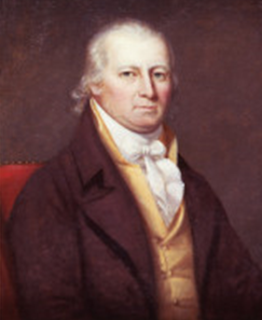
The store owner and family man (above) was swept up in the revolutionary fervor in New York and Philadelphia in the 1770s. He spoke out publicly on British abuses of colonists’ rights and signed a letter that was published in the January 23, 1770, New York Gazette supporting the strongly anti-British Non Importation Resolutions of 1765. He also participated in running the British blockade of Philadelphia. On October 31, 1778, at age 43, Jonas Phillips joined a Philadelphia militia unit, Capt. John Linton’s Company of Col. William Bradford’s Battalion, as a private.
Jonas Phillips also was an outspoken proponent of freedom of religion. He famously wrote a September 7, 1787, letter on that subject to the Constitutional Convention, which had been meeting since May of that year in Philadelphia to draft a document—which would become the U.S. Constitution—that addressed problems with the weak central government created by the Articles of Confederation.
Identifying himself in the letter as “one of the people called Jews of the City of Philadelphia,” Jonas Phillips called on the Convention to insert provisions in the forthcoming Constitution to provide all men “the natural and unalienable Right to worship almighty God according to their own Conscience and understanding.”
*************
Jonas Phillips was instrumental in raising funds to purchase a new building for the Mikveh Israel synagogue in Philadelphia in 1782. He later was elected the president of that Spanish and Portuguese Congregation, which had been established in 1840. As the head of the congregation, he invited George Washington to attend the dedication ceremonies of its new building.
Jonas Phillips died in Philadelphia in 1803. Rebecca Phillips outlived him by 28 years. Their daughter Rachel had married Michael Levy in Philadelphia in June 1787 when she was 18 years old. Uriah came along in 1792. Family lore has it that the boy idolized his patriotic grandfather. Uriah, the story goes, influenced by his grandfather, had two idols growing up, George Washington and John Paul Jones.
Which might explain why Uriah ran away from home at ten to be a cabin boy on a ship, was part owner of a merchant ship when he was 19, and the following year, 1812, joined the U.S. Navy to fight the British in the war that began that year. In 1834, Uriah purchased Thomas Jefferson’s Monticello, in part because of his admiration for Jefferson’s strong advocacy of religious freedom.
The grandson did not fall far from his grandfather’s tree, inheriting—and acting upon—his love of country and devotion to freedom of religion.
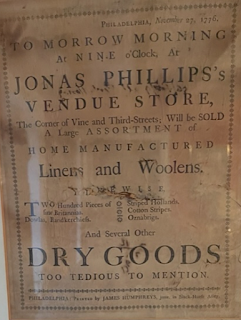
As for the 1776 advertisement above, I am indebted to Nancy Hoffman, a Phillips family descendant, who kindly sent me the image. It’s “the oldest piece of my family’s history that I own,” she said in an email. “I do have a few jewelry objects too, but nothing beats this!”
THE DOC: Steven Pressman’s great documentary, The Levys of Monticello, continues to appear at film festivals. Last month the film received the Audience Award for Best Feature documentary at the 42ndPhiladelphia Jewish Film Festival.
It continues to get great reviews, including this one by Julia Klein published November 30 in The Forward: https://tinyurl.com/43nv3cyw
In it, she notes that the doc “draws the essentials of this distinctively American story” from Saving Monticello, and opines that Susan Stein, Niya Bates, and I offer “pithy commentary” in the movie. I don’t disagree.

For more on the film, go to https://tinyurl.com/43nv3cyw
EVENTS: On Thursday Evening, November 3, I took part in one of the most memorable events I’ve had since the publication of Saving Monticello in November 2001: a reception, a screening of The Levys of Monticello, and a Q&A at the Monticello Visitor Center for the trustees of the Thomas Jefferson Foundation and guests.
It was a crisp fall evening as we mixed and mingled in the Visitor Center courtyard and feasted on a buffet prepared by the Monticello Farm Table café.
Then came the screening—complete with popcorn (and wine)—following a gracious introduction by Leslie Greene Bowman, the Foundation’s president.
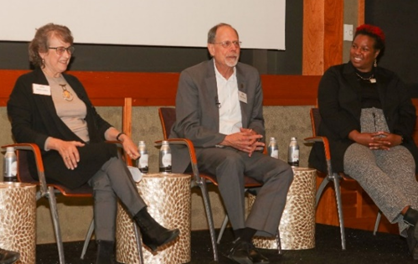
Afterward, we had an engaging Q&A moderated by Susan Stein, Monticello’s long-time curator. I joined U-Va. History Professor Emerita Phyllis Leffler and Niya Bates, the former head of Monticello’s pioneering Getting Word African American Oral History Project (flanking me the photo)—both of whom are featured in the documentary, along with Steve Pressman.
On, Sunday, November 5, we took in a Virginia Film Festival screening of the doc at the beautifully restored Paramount Theater on the Charlottesville downtown mall, which drew some 850 people. Wjke followed that with another Q&A. It was a memorable weekend.
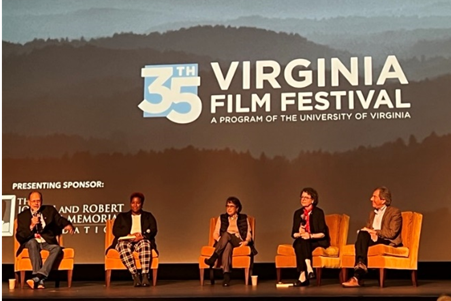
If you’d like to arrange an event for Saving Monticello or for any of my other books, please email me at marcleepson@gmail.comFor details on upcoming events, check the Events page on my website: https://bit.ly/NewAppearances
GIFT IDEAS: For a personally autographed, brand-new paperback copy of Saving Monticello, please e-mail marcleepson@gmail.com I also have a few as-new, unopened hardcover copies, along with a good selection of new copies of my other books: Flag: An American Biography; Desperate Engagement; What So Proudly We Hailed; Flag: An American Biography; and Ballad of the Green Beret: The Life and Wars of Staff Sgt. Barry Sadler.
November 8, 2022
November 2022
Saving Monticello: The Newsletter
The latest about the book, author events, and more
Newsletter Editor - Marc Leepson
Volume XIX, Number 11 November 2022
“The study of the past is a constantly evolving, never-ending journey of discovery.” – Eric Foner

THE MISTRESS OF MONTICELLO:“The greetings of South Carolina to the Master of Monticello—Floride Cunningham.”
Those words are inscribed to Jefferson Monroe Levy in a copy of the second edition of Miss Washington of Virginia: A Semi-Centennial Love Story, a privately published novel by Jeannie Blackburn, writing as “Mrs. F. Berger Moran.” Originally published in 1889, this edition of the short, melodramatic fictional account of the courtship of young Marie Washington, a grandniece of George Washington, came out in 1893.
Levy descendant Richard Lewis recently came across the volume among his late mother Harley Lewis’ books, and kindly sent images of the inscription. Miss Washington is a 19th century romance novel with a plot and ending that will surprise no one. Plus, it’s filled with cringe-worthy racist tropes whenever an enslaved person is mentioned.
That said, there is historical value in the book: the short but illuminating sketch of Jefferson Levy’s mother, Francis Mitchell (Fanny) Levy, which mentions, her role at Monticello during the first 13 years that her son owned the property. Jefferson Levy paid for the second printing; and Jeannie Blackburn wrote a short “In Memorium” about his mother, who had died in 1892 and was a fan of the book.
While researching Saving Monticellotwenty-plus-years ago, I found a small amount of material that that shed light on the time Fanny Levy’s spent at Monticello, primarily letters that she wrote in 1881 to her sons Louis and Jefferson Levy and her son-in-law Marcus Ryttenburg in New York. They contained first-person accounts of the work Jefferson Levy did to repair, preserve, and restore the place after he bought out the other heirs of Uriah Levy in 1879, following a seventeen-year period in which the house and grounds had been all but neglected since his uncle’s death in 1862.
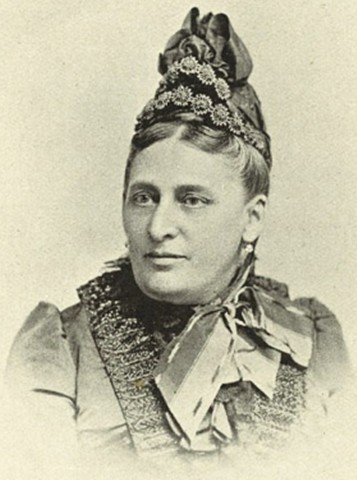 Portrait of Fanny LevyMonticello, Fanny Levy wrote on July 4 1881, to her son Louis, “is looking elegant,” the “grounds and scenery [are] magnificent.” Fanny Levy said, enjoyed a staff of “splendid servants,” including "a good cook and waitress."
Portrait of Fanny LevyMonticello, Fanny Levy wrote on July 4 1881, to her son Louis, “is looking elegant,” the “grounds and scenery [are] magnificent.” Fanny Levy said, enjoyed a staff of “splendid servants,” including "a good cook and waitress."
I also found references to one of the first large events held at Monticello, a fund-raising Colonial Ball Jefferson Levy put on to benefit the Albemarle County chapter of the Daughters of the American Revolution. A local newspaper reported that Fanny Levy “came down from New York to be [her bachelor son’s] hostess,” wearing “a colonial outfit of lavender in which she had her portrait painted later." The newspaper called the fundraising event “one of the most brilliant entertainments ever given in Albemarle County.”
What Jeannie Blackburn wrote in Miss Washington’s “In Memorium” adds to the picture of Fanny Levy’s time at Monticello. She “was widely known as the charming hostess of Monticello,” Blackburn wrote, “and will always be remembered as a lovely woman, cordial in her manner, giving genuine kind welcome to Monticello, taking great pleasure in showing the beauties of the old home to all her guests, and taking great care to have Monticello kept in the colonial style of the days of Jefferson.”
Fanny Levy “entertained many visitors at this grand old homestead, among them many prominent personages.” In 1889, Blackburn noted, “President Cleveland and some of his cabinet were guests.” Virginia, she said, “has lost a good friend in Fanny Mitchell Levy, Monticello a cherished mistress, and her children a mother who can never be replaced.”
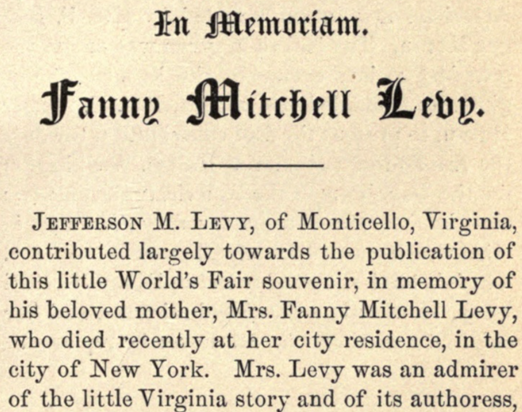
As far as the inscription to Jefferson Levy is concerned, the woman who wrote it, Floride Cunningham of South Carolina, was the niece of Ann Pamela Cunningham, who founded the Ladies Association of Mount Vernon in 1856, which purchased George Washington's home—and owns and operates it to this day—from Washington’s nephew, who was about to sell the property to become residential housing lots.
Anne Pamela Cunningham often is cited as the first American house preservationist—but I’ve long contended that that honor should go to Uriah Levy, who did what she did at Monticello twenty years earlier, in 1835.
JEFFERSON’S JEWISH GRANDCHILDREN: Yes, you read that correctly. I recently learned the details in a revealing November 2020 essay, “The Jewish Grandchildren of Sally Hemings and Thomas Jefferson,” by University of Virginia History Professor James Loeffler, who directs the university’s Jewish Studies Program.
The story begins early in the early 19th century with the common law marriage of David Isaacs and Nancy West. Isaacs was a Jewish man who had emigrated from Germany and ran Charlottesville’s general store. West was a “free mixed-race woman,” Professor Loeffler writes, who “owned localproperty, ran a bakery, and launched one of the country’s first African-American newspapers.”
In 1822, the couple—who were raising seven children—were hauled into court and indicted for the crime of “interracial miscegenation.” After fighting the charges for five years, the couple prevailed.
In 1832, one of their daughters, Julia Ann Isaacs, married Eston Hemings. He was the youngest son of Sally Hemings, a mixed-race (her mother was biracial and her father was John Wayles, Thomas Jefferson’s father-in-law) enslaved woman at Monticello.
DNA and historical evidence strongly suggest that Thomas Jefferson was the father of Eston Hemings and his six siblings. Eston Hemings, who was born in 1808, had been freed by Thomas Jefferson in his will following his death on July 4, 1826.
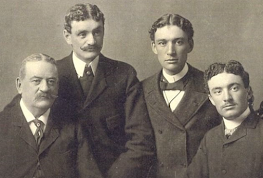 Eston and Julia Ann Hemings’ first child, John Wayles Hemings, was born in Charlottesville in 1835. He later served as a Union officer in the Civil War. The couple had two other children, including Beverly Frederick Hemings (in the photo with his sons), who was born in Ohio in 1839 after the family moved west.
Eston and Julia Ann Hemings’ first child, John Wayles Hemings, was born in Charlottesville in 1835. He later served as a Union officer in the Civil War. The couple had two other children, including Beverly Frederick Hemings (in the photo with his sons), who was born in Ohio in 1839 after the family moved west.
They later moved to Madison, Wisconsin, where they changed their last name to Jefferson. And, although Julia Ann’s father was Jewish, the entire family “began to identify publicly as [Thomas] Jefferson’s white, Christian descendants.”
You can read the entire essay at https://tinyurl.com/TJGrandchildren
Special thanks to my friend and Saving Monticello Newsletter subscriber Amoret Bruguiere for bringing Professor Loeffler’s essay to my attention.
THE DOC: Steven Pressman’s great documentary, The Levys of Monticello, continues to appear at film festivals. There’s an in-person screening on Sunday, November 6, at the Virginia Film Festival in Charlottesville, after which I’ll be taking part in a Q&A with Steve, Susan Stein, Phyllis Leffler, and Niya Bates.
The next screening is set for November 13 at the Philadelphia Jewish Film Festival in partnership with Philadelphia’s National Museum of American Jewish History.
For more info, go to https://bit.ly/LevyDoc
EVENTS: On Saturday afternoon, November 5, I will sign copies of Saving Monticello at the Monticello Gift Shop on the Mountaintop—the day before the Sunday, November 6screening at the beautifully restored Paramount Theater on the Downtown Mall in Charlottesville.
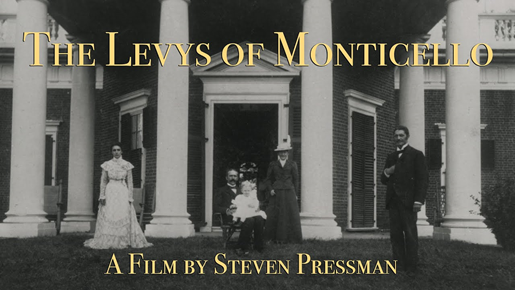
If you’d like to arrange an event for Saving Monticello or for any of my other books, email me at marcleepson@gmail.comFor details on other upcoming events, check the Events page on my website: https://bit.ly/NewAppearances
GIFT IDEAS: For a personally autographed, brand-new paperback copy of Saving Monticello, please e-mail marcleepson@gmail.com I also have a few as-new, unopened hardcover copies, along with a good selection of new copies of my other books: Flag: An American Biography; Desperate Engagement; What So Proudly We Hailed; Flag: An American Biography; and Ballad of the Green Beret: The Life and Wars of Staff Sgt. Barry Sadler.
October 6, 2022
Saving Monticello: The NewsletterThe latest about the bo...
Saving Monticello: The Newsletter
The latest about the book, author events, and more
Newsletter Editor - Marc Leepson
Volume XIX, Number 10 October 2022
“The study of the past is a constantly evolving,never-ending journey of discovery.” – Eric Foner

AN IDEAL PLACE TOPLAY:It’s not everyday that you get to read a first-person account of a visit to Monticello in1940, much less one written by a Levy Family descendant. But I was fortunateenough last month to receive a copy of “Spring at Monticello,” a scrapbookentry written by Nancy Hoffman, a granddaughter of L. Napoleon Levy—and agrandniece of his brother, Jefferson M. Levy who owned Monticello from 1879 to1923.
In hershort account, Nancy Hoffman describes a visit to the mountaintop she made thatyear when she was ten years old with her sister Pam, their mother AlmaHendricks Levy Bookman, and three family friends—a mother and her two daughters.Many thanks to Nancy’s son Rob Hoffman for kindly scanning and emailing it tome.
Themothers and daughters piled into the Bookman family station wagon in New Yorkand drove south to their first stop in Virginia, Colonial Williamsburg. Touringthe restored 18th century buildings, Nancy Hoffman wrote, was “a ten-year-old’sdream come true.”
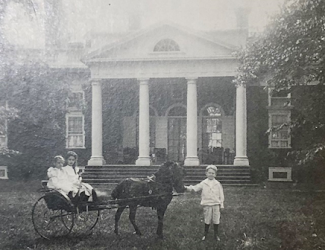
A highlight for the New Yorkers was a meal featuringSouthern fried chicken and Virginia ham biscuits; another was running intoKatherine Hepburn in one of the historic houses. “For us kids, it was a first,”she wrote, “and a huge treat to have been so close to living, breathing, bigmovie star.”
Thenext stop was Monticello. When Nancy’s mother drove up to the old gatehouse thatwas used to greet visitors in those days, an older African American man “cameout to see who we were,” Nancy remembered. “When he saw my mother behind thewheel, his face lit up and he cried out incredulously, his voice rising as hespoke, ‘Alma??? Alma???’”
Theman “recognized my mother from long ago [visits],” Nancy wrote, as he had workedat Monticello for Jefferson Levy. “But the astonishing part was that he had notseen my mother since she was a young girl. Here she was all grown up, behindthe wheel of an automobile, yet he knew her immediately, and with obviousaffection, called out her name.”
Hermother, Nancy said, “called his name with some surprise, nodded her head andaffirmed that she was indeed Alma. Mother offered him a ride up to the house.”The “fragile, white-haired” man seemed reticent at first, then said he wouldhave to get permission to join them. So, Nancy said, “He got on the phone andreceived the okay to accompany us.”
Theman—whose name Nancy could not recall when she wrote the remembrance—likely wasWilliam Page, the husband of Lucy Coleman Barnaby Page, who had been thegatekeeper at Monticello since 1932. William Page was one of the first tourguides at Monticello in 1923 when the Thomas Jefferson Memorial Foundation purchasedthe place from Jefferson Levy.
The family drove up from thegatehouse to Monticello and had a private tour of the house. As the man and hermother reminisced,” Nancy wrote, “he took us up to the third floor, theclosed-off rotunda where my mother, her siblings and cousins used to stay whenthey spent the summer there with their Uncle Jeff.”
Monticello, she remembered, “appeared like a vast open indoor space, floodedwith light and an ideal place to play. I could picture us dressing up andputting on plays. My mother seemed like the luckiest little girl in the worldto have spent summers there with her family.”
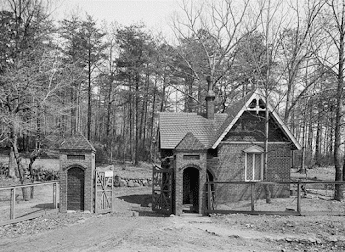
It“was a glorious visit and one of the best vacations I ever spent, wallowing inAmerica’s past, enjoying Virginia’s culinary expertise and being treated soroyally at my young age in such a magnificent mansion that my mother, forseveral summers, had called home.”
THE DOC: Steven Pressman’s great doc, The Levys of Monticello, is being screened at several filmfestivals this fall. On October 10, it’ll be shown at the Jacob Burns FilmCenter as part of the Westchester Jewish FilmFestival. There’s an in-person screening on Sunday, November 6, at the Virginia Film Festival in Charlottesville, after which I’ll be taking part in aQ&A with Steve, Susan Stein, and Niya Bates. The next screening is set for November 13 at the PhiladelphiaJewish Film Festival in partnership with Philadelphia’s National Museum ofAmerican Jewish History.
For more info,go to https://bit.ly/LevyDoc
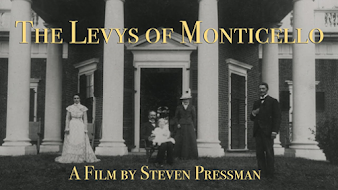
EVENTS: I’llbe doing three book talks in October. On Sunday,October 2, I have a Zoom talk on SavingMonticello for the Shearith IsraelSisterhood book club in Dallas.
I’llbe speaking about my book What So ProudlyWe Hailed: Francis Scott Key, A Life, on Thursday, October 6, at the luncheon meeting of the Alexandria(Va.) Committee of Colonial Dames.
AndI’ll be doing a talk on Flag: An AmericanBiography on Tuesday, October 11,for the Kate Waller Barret DAR Chapter in Mount Vernon, Virginia.
If you’dlike to arrange an event for SavingMonticello or for any of my other books, email me at marcleepson@gmail.comFor details on other upcoming events, check the Events page on my website: https://bit.ly/NewAppearances
GIFT IDEAS: For a personally autographed, brand-new paperback copy of Saving Monticello, please e-mail marcleepson@gmail.com I also have a few as-new, unopened hardcovercopies, along with a good selection of new copies of my other books: Flag: An American Biography; DesperateEngagement; What So Proudly We Hailed; Flag:An American Biography; and Ballad ofthe Green Beret: The Life and Wars of Staff Sgt. Barry Sadler.
The SMNewsletter on Line: You can read back issues of thisnewsletter at http://bit.ly/SMOnline
Saving Monticello: The Newsletter The latest about the b...
Saving Monticello: The Newsletter
The latest about the book, author events, and more
Newsletter Editor - Marc Leepson
Volume XIX, Number 10 October 2022
“The study of the past is a constantly evolving, never-ending journey of discovery.” – Eric Foner

AN IDEAL PLACE TO PLAY:It’s not every day that you get to read a first-person account of a visit to Monticello in 1940, much less one written by a Levy Family descendant. But I was fortunate enough last month to receive a copy of “Spring at Monticello,” a scrapbook entry written by Nancy Hoffman, a granddaughter of L. Napoleon Levy—and a grandniece of his brother, Jefferson M. Levy who owned Monticello from 1879 to 1923.
In her short account, Nancy Hoffman describes a visit to the mountaintop she made that year when she was ten years old with her sister Pam, their mother Alma Hendricks Levy Bookman, and three family friends—a mother and her two daughters. Many thanks to Nancy’s son Rob Hoffman for kindly scanning and emailing it to me.
The mothers and daughters piled into the Bookman family station wagon in New York and drove south to their first stop in Virginia, Colonial Williamsburg. Touring the restored 18th century buildings, Nancy Hoffman wrote, was “a ten-year-old’s dream come true.”

A highlight for the New Yorkers was a meal featuring Southern fried chicken and Virginia ham biscuits; another was running into Katherine Hepburn in one of the historic houses. “For us kids, it was a first,” she wrote, “and a huge treat to have been so close to living, breathing, big movie star.”
The next stop was Monticello. When Nancy’s mother drove up to the old gatehouse that was used to greet visitors in those days, an older African American man “came out to see who we were,” Nancy remembered. “When he saw my mother behind the wheel, his face lit up and he cried out incredulously, his voice rising as he spoke, ‘Alma??? Alma???’”
The man “recognized my mother from long ago [visits],” Nancy wrote, as he had worked at Monticello for Jefferson Levy. “But the astonishing part was that he had not seen my mother since she was a young girl. Here she was all grown up, behind the wheel of an automobile, yet he knew her immediately, and with obvious affection, called out her name.”
Her mother, Nancy said, “called his name with some surprise, nodded her head and affirmed that she was indeed Alma. Mother offered him a ride up to the house.” The “fragile, white-haired” man seemed reticent at first, then said he would have to get permission to join them. So, Nancy said, “He got on the phone and received the okay to accompany us.”
The man—whose name Nancy could not recall when she wrote the remembrance—likely was William Page, the husband of Lucy Coleman Barnaby Page, who had been the gatekeeper at Monticello since 1932. William Page was one of the first tour guides at Monticello in 1923 when the Thomas Jefferson Memorial Foundation purchased the place from Jefferson Levy.
The family drove up from the gatehouse to Monticello and had a private tour of the house. As the man and her mother reminisced,” Nancy wrote, “he took us up to the third floor, the closed-off rotunda where my mother, her siblings and cousins used to stay when they spent the summer there with their Uncle Jeff.”
Monticello, she remembered, “appeared like a vast open indoor space, flooded with light and an ideal place to play. I could picture us dressing up and putting on plays. My mother seemed like the luckiest little girl in the world to have spent summers there with her family.”

It “was a glorious visit and one of the best vacations I ever spent, wallowing in America’s past, enjoying Virginia’s culinary expertise and being treated so royally at my young age in such a magnificent mansion that my mother, for several summers, had called home.”
THE DOC: Steven Pressman’s great doc, The Levys of Monticello, is being screened at several film festivals this fall. On October 10, it’ll be shown at the Jacob Burns Film Center as part of the Westchester Jewish Film Festival. There’s an in-person screening on Sunday, November 6, at the Virginia Film Festival in Charlottesville, after which I’ll be taking part in a Q&A with Steve, Susan Stein, and Niya Bates. The next screening is set for November 13 at the Philadelphia Jewish Film Festival in partnership with Philadelphia’s National Museum of American Jewish History.
For more info, go to https://bit.ly/LevyDoc

EVENTS: I’ll be doing three book talks in October. On Sunday, October 2, I have a Zoom talk on Saving Monticello for the Shearith Israel Sisterhood book club in Dallas.
I’ll be speaking about my book What So Proudly We Hailed: Francis Scott Key, A Life, on Thursday, October 6, at the luncheon meeting of the Alexandria (Va.) Committee of Colonial Dames.
And I’ll be doing a talk on Flag: An American Biography on Tuesday, October 11, for the Kate Waller Barret DAR Chapter in Mount Vernon, Virginia.
If you’d like to arrange an event for Saving Monticello or for any of my other books, email me at marcleepson@gmail.comFor details on other upcoming events, check the Events page on my website: https://bit.ly/NewAppearances
GIFT IDEAS: For a personally autographed, brand-new paperback copy of Saving Monticello, please e-mail marcleepson@gmail.com I also have a few as-new, unopened hardcover copies, along with a good selection of new copies of my other books: Flag: An American Biography; Desperate Engagement; What So Proudly We Hailed; Flag: An American Biography; and Ballad of the Green Beret: The Life and Wars of Staff Sgt. Barry Sadler.
The SM Newsletter on Line: You can read back issues of this newsletter at http://bit.ly/SMOnline





